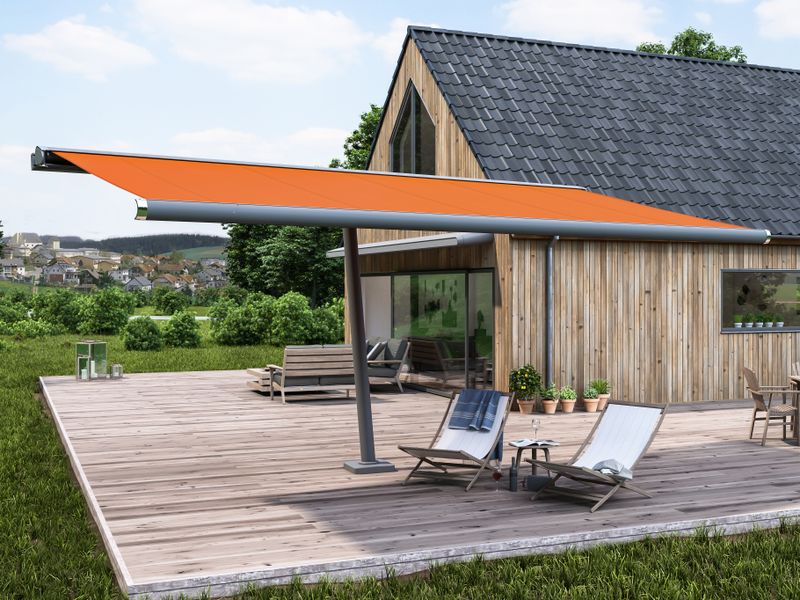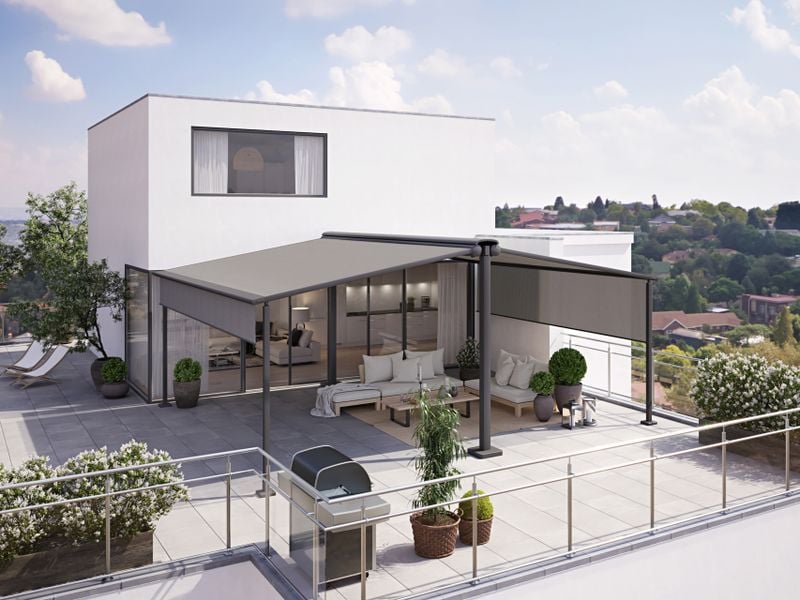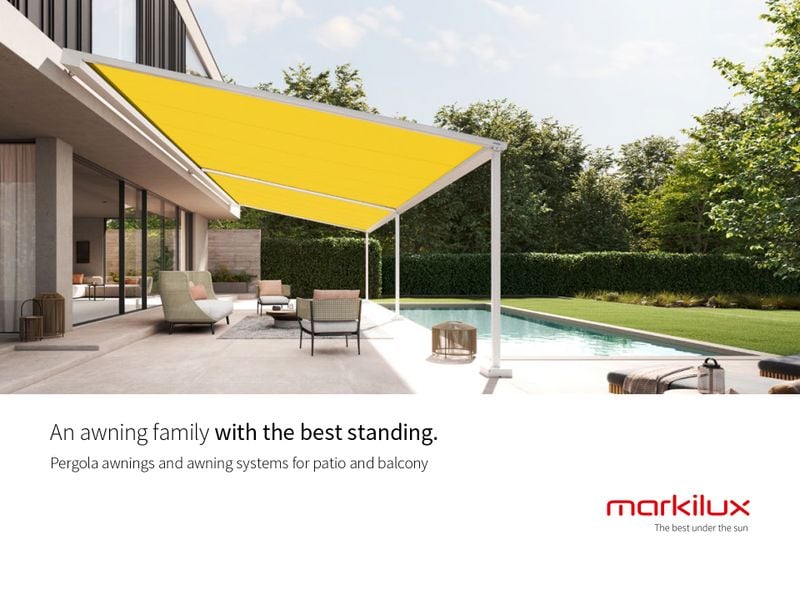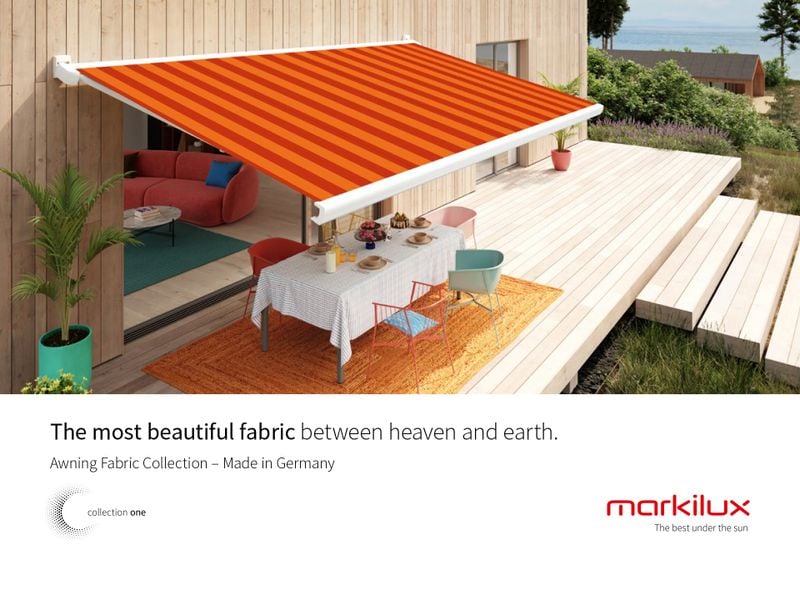Freestanding awnings from markilux. Sun protection always where you need it.

Freestandingawnings from markilux: flexibility meets design
Freestanding awnings are an elegant and versatile solution for your sun protection needs. At markilux, we understand that every challenge requires a customized solution. That's why we offer high-quality products to meet your needs. On the one hand, our range includes freestanding systems that can be combined with markilux folding-arm awnings or markilux pergola models. On the other hand, there is our exclusive markilux markant awning system, which can be optionally supplemented with external blinds and panoramic windows.
Discover freestanding awnings from markilux in detail.
Our extensive range of freestanding awnings opens up countless possibilities. Get to know the variety of our products and the convenience of our customized solutions. With markilux, you always get the right solution for your sun protection.
Freestanding awnings are more than just sun protection - they're a statement in style and functionality. Discover the quality and variety of our freestanding awning systems and enjoy the freedom to design your product according to your wishes. At markilux you will find the right one for every requirement.
markilux markant
The markilux markant awning system is more than just a sunshade - it's an expression of style and functionality. Discover the quality and variety of our markilux markant system and enjoy the freedom to customize it to your liking. No matter where you need sun protection, markilux markant is the right choice for your outdoor space.
Product advantages
Freestanding awning system
Perfect sun, rain and weather protection
Flexible outdoor use: in the garden or by the pool
Purist design


For all-round protection: markilux markant easily extendable
markilux planet
The markilux planet offers maximum flexibility in the design of the outdoor area, as it can be placed in any location. It effectively protects against the sun and UV rays and allows you to adjust the shade zone as needed. It can be equipped with a markilux designer awning of your choice and is always a real eye-catcher.
Product advantages
Free standing awning parasol
Can be combined with folding-arm awning of your choice
Flexible adjustment: 335° rotatable
Design highlight


markilux syncra
The markilux syncra is a custom-made, freestanding double awning that is ideal for large outdoor seating areas or can serve as a free pergola awning with high wind stability. This versatile awning stand system offers several advantages:
Product advantages
Free-standing awning stand system for large areas
Fixing of folding arm awnings or pergolas on both sides
Mounting on concrete foundations or with stabilisation boxes
Wind stability

Advantages of free-standing awnings
Freestanding awnings are a versatile and functional addition to any outdoor space. Not only do they offer protection from the sun, rain and other weather conditions, they can also be customised to match the design of your home and garden. This creates a harmonious aesthetic. Whether you want to shade a large area or need targeted protection in a smaller zone, freestanding awnings are flexible in size and placement. With our equipment options, you can make your outdoor area cosy and with the appropriate accessories, your awning will be weatherproof.
One of the biggest advantages of free-standing awnings is that you can use them to provide shade away from a building. While classic awnings are attached to the façade of a building, free-standing solar protection solutions can be positioned anywhere. They can therefore be set up and installed anywhere. Do you have a second patio at the back of the garden? Would you like to enjoy shade around your pool? Is your patio directly adjacent to the building, but a fixture in the façade is not desired or possible? In all these cases, a free-standing system is the right choice. Whether for large areas or rather small areas, whether a single awning, double awning or awning system - with the free-standing awnings from markilux you will find the right awning for every situation.
The freestanding awning models can also be fitted with additional equipment such as light or infrared heaters. The markilux markant free-standing awning system can also be supplemented with markilux format vertical roller blinds or side awnings. This creates all-round protection from the sun and other weather influences such as wind and rain. Another advantage is that these additional side elements create a private outdoor space in which privacy is maintained. Design your outdoor area to be functional, aesthetic and inviting both during the day and at night with freestanding awnings from markilux.
FAQ about freestanding awnings from markilux
Freestanding awnings are awnings that do not have to be attached to a building. In some cases, the structural conditions do not allow an awning to be attached to the façade. Or there is no building nearby. This may be the case, for example, if you have a second terrace away from the house or would like to shade your pool area. In such cases, you don't have to do without an awning at all, but can simply fall back on the free-standing awning models.
If you still want a classic folding-arm awning, the markilux planet or markilux syncra models are suitable. The markilux planet is a type of awning parasol with a round aluminium post and angular cross-beam for attaching one of our folding-arm awnings. This makes it an ideal design element for your outdoor area. A special highlight: in the flex version, it can be swivelled up to 335° so that it can move with the sun and provide perfect shade at all times.
The markilux syncra awning stand system is stylish solar protection for large areas. This is a free-standing system made of aluminium that can be combined with folding-arm awnings or the markilux pergola models. This means that awnings can be installed in open areas, either with a concrete foundation or, for even more flexibility, with ballast boxes. For shading large areas, awnings can be attached to both sides of the cross-beam to create a double awning.
The third freestanding model to choose from is markilux markant, a cuboid awning system for sun and all-weather protection. This model is ideal for covering large areas. In combination with markilux vertical roller blinds and the markilux format side elements, it creates an outdoor retreat.
You can complete the free-standing awnings with additional equipment such as LED lighting, infrared heaters or convenient operating options, e.g. remote control, app or weather-dependent sensors.
Yes, freestanding awnings are specially designed to withstand weather conditions such as sun, rain and even wind. They are made from weatherproof materials that are both robust and durable.
Depending on the type of fabric, the fabrics of the awnings are water-repellent and UV-resistant. This means they not only protect you from the sun's harmful UV rays, but also from light rain.
The awning frame is made of high-quality materials such as aluminium, which is known for its strength and durability.
However, although freestanding awnings are stable and resistant, extreme weather conditions such as storms or hail can still cause damage. We therefore recommend retracting the awning during bad weather to maximise its operating life and prevent damage. With various equipment options, you can turn your awning into a weatherproof awning.
Yes, there are a variety of awning covers and frame colours to choose from to match your awning to the aesthetics of your home.
In addition, with the markilux syncra and the markilux planet, you can choose which awning to attach to the upright systems.
There are models that allow very large areas to be shaded. The markilux markant is particularly suitable for large areas. The maximum size of a single awning is 3 x 6 metres. As a double system, you can double this area to a total of 36 square metres.
Yes, various lighting options such as LED-Line or LED-Spots are available for many freestanding models. Infrared heaters can also be integrated.
Yes, many models offer the option of integrating additional components to extend your privacy and protect you from low sun, wind and weather. With the markilux markant model, for example, it is possible to attach markilux format side elements or vertical roller blinds.
Our awnings are always professionally installed by a markilux specialist dealer. Depending on which model you choose, a concrete foundation is required. If you prefer an installation that requires less effort, ballast boxes are available for the markilux syncra model, for example.
The same care instructions apply to freestanding awnings as for other awning types. Take a look at our tips and tricks for cleaning awnings.








